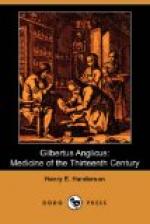Intestinal worms are not generated in the stomach, as Gilbert says, because of the great heat produced by the process of digestion. In the intestines they originate chiefly from the varieties of phlegm, e.g., saline, sweet, acid, natural, etc. The species mentioned specifically are lumbrici and ascarides or cucubitini, though the terms long, round, short and broad are also employed, and probably include the tape worm or taenia lata. The treatment of these parasites consists generally in the use of aromatic, bitter or acid mixtures, among which gentian, serpentaria, tithymal and cucumis agrestis are especially commended for lumbrici, and enemata of wormwood, lupinus, scammony, salt, aloes, etc., for ascarides.
The diseases of the liver, though not numerous, are allotted considerable space most of which is occupied by scholastic speculations and the usual rich supply of therapeutical suggestions.
Discrasia of the liver has several varieties, warm, cold, moist and dry, and seems nearly equivalent to our somewhat overworked term of “biliousness.” Gilbert’s favorite compounds for the relief of this condition are the Trifera sarracenica, the Electuarium psilliticum and above all the Dyantos Besonis.
Obstruction (oppilatio) of the liver or enfraxis is defined as a disease of the canals (pori), of which four are enumerated, to-wit, the meseraic, that of the convexity of the organ (gibbus—ubi sunt exitus capillarium venarum), the duct leading to the gall-bladder and that leading to the spleen. With an abundance of symptoms, it is singular that this comprehensive disease does not seem characterized by any constant or severe pain, as we might reasonably expect.
Abscess of the liver depends upon some vice of the blood, the bile, the phlegm or the black-bile. The general treatment is poultices and other maturatives, but, as the author adds rather sadly at the close, ultima cura est per incisionem.
Dropsy is discussed as an independent disease through the exhaustive speculations of thirty-two pages. Gilbert tells us it depends upon some fault of the digestive faculty of the liver, and he divides it into four species, to-wit, leucoflantia, yposarcha, alchitis and tympanitis, each of which has its special and appropriate treatment. In the dreary waste of speculative discussion it is cheering, however, to observe Gilbert’s positive recognition of the sphere of percussion indicated in the passage:
“Et venter percussus sonat ad modum utris semipleni aqua et venta.” (f. 250b.)
Ycteritia or jaundice receives equally thorough discussion through eight weary pages, including the usual polypharmacal treatment.




